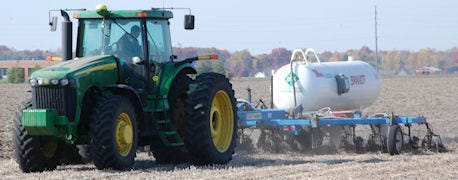
So much of coffee-shop talk is exactly that – talk.
When it appeared the rules for transporting anhydrous ammonia were becoming entwined with myth, the Illinois Fertilizer and Chemical Association decided to sort through the mess.
IFCA president Jean Payne remembers a member called the office after a driver had been ticketed while towing two anhydrous ammonia nurse tanks. According to the ticket, the driver could pull a maximum of one nurse tank.
IFCA worked with the Illinois State Police to rescind the violation. In the process, Payne confirmed the Illinois Vehicle Code allows up to three vehicles in combination.

Anhydrous Ammonia Nurse Tank Transportation Rules Clarified
Additionally, Payne inquired about another area of confusion – the license requirements for transporting nurse tanks.
Payne explains that she was under the impression that gross vehicle weight did not trigger a Class A requirement when towing implements of husbandry. In checking on this issue, IFCA worked with ISP and the Illinois Secretary of State's Office to set the record straight.
Related: Check soil temperatures before applying anhydrous ammonia
Here is what they found out.
•Farmers are not required to hold a commercial driver's license when towing anhydrous ammonia nurse tanks. This is a federal exemption that was adopted into Illinois law.
•Retailers transporting anhydrous ammonia, which is a placarded hazardous material, should carry a Class B CDL with hazmat endorsement. A Class A CDL also works, but is not required.
•An anhydrous ammonia tank is an implement of husbandry and, as such, the weight is not factored into the CDL weight classification.
•The Illinois vehicle code allows a maximum of three vehicles to be transported in combination. This means a truck or tractor may legally pull up to two nurse tanks in tandem. •A tractor pulling a toolbar and a nurse tank is another example of legal transport.
•Seasonal employees have the option of obtaining a farm service restricted CDL from the •Secretary of State, which is good for two 90-day periods or one 180-day period each year. •The restricted CDL does not require the hazmat endorsement.
~~~PAGE_BREAK_HERE~~~
Payne notes an old chart that indicates a Class A CDL with hazmat plus doubles and triples endorsement is required to pull two 1,450 gallon nurse tanks. This chart is incorrect.
Moving forward, she encourages folks to consult www.ifca.com for additional questions.
Also, should a driver who is following these guidelines receive a ticket that they feel is in error, Payne encourages the company or driver to contact IFCA with assistance in challenging the ruling.
For ag retailers, a citation will go on their record with the Illinois Department of Transportation and can impact insurance rates and the company's overall safety rating.
"Law enforcement officers have a difficult job and the Vehicle Code is a large book with numerous exceptions for agriculture," Payne notes. "It's better for industry and law enforcement to ensure accuracy in any enforcement action."
About the Author(s)
You May Also Like




